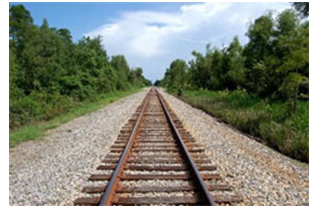Holste Says... |
 |
| There now appears to be some serious pressure being applied to politicians to reduce the impact that these types of regulations/standards have on business and consumers here in the US. |
 |
What do you say? |
 |
| Click here to send us your comments |
|
|
|
Developing, setting, and maintaining standards are important functions of the Federal Government as well as industry trade associations. In the logistics industry there are of course many important regulations/standards, such as the shipping compliance labeling standard known as UCC/GS1-128. Think of the confusion that would exist without this type of regulation. Bar code scanning and automation would not be possible without compliance to the Uniform Product Code (UPC) standard. In that regard, I ran across an interesting NARA standard that has a connection to supply chain logistics. It deals with how the standard U.S. rail gauge specification came to be precisely 4 feet 8½ inches.
Seems like a decidedly odd number doesn't it? Well, it turns out there is a very interesting reason for this particular specification.
 To understand the genesis of the number, you have to first step back historically. American railroads were largely engineered and built by British expatriates. Since the standard rail gauge in England was 4 feet 8½ inches, they apparently figured that would be the right number here in North America, as well. "But," you might ask, "Why is that the rail gauge in England?" Well, it's because early English railroads were built by the same people who built horse-drawn wagons. Those wagon wheels were spaced precisely (are you catching on here?) 4 feet 8½ inches apart. Why? Because if they had used a different spacing, the wagons would have broken on old European roads that were full of ruts that just happened to be 4 feet 8½ inches apart. To understand the genesis of the number, you have to first step back historically. American railroads were largely engineered and built by British expatriates. Since the standard rail gauge in England was 4 feet 8½ inches, they apparently figured that would be the right number here in North America, as well. "But," you might ask, "Why is that the rail gauge in England?" Well, it's because early English railroads were built by the same people who built horse-drawn wagons. Those wagon wheels were spaced precisely (are you catching on here?) 4 feet 8½ inches apart. Why? Because if they had used a different spacing, the wagons would have broken on old European roads that were full of ruts that just happened to be 4 feet 8½ inches apart.
So, you may ask, how did these roads come to have all these ruts spaced at such a seemingly arbitrary distance? You must keep in mind that many of the long-distance roads on the Continent were built to allow movement of the Imperial Roman legions and have been in use ever since. The ruts were made by some of the first vehicles to travel these roads - the war chariots of Roman armies. Once the ruts were established, other wagons had to match the ruts or risk damaging their wheels and axles.
And finally, "Why were the wheels on a Roman war chariot exactly 4 feet 8½ inches apart?" Because, that was the average width of the backsides of the two warhorses used to power it. So, next time you ask, "What horse's ass came up with that specification," you may have answered your own question simply by asking it!
It turns out, actually, that it took quite awhile for the standard to really take hold in the US.
According to the Encyclopedia of American Business History and Biography, at the beginning of the Civil War, there were more than 20 different gauges in use (although the 4 foot 8½ inch was the most widely used). During the war, any supplies transported by rail had to be transferred by hand whenever a car on one gauge encountered track of another gauge and more than 4,000 miles of new track was laid during the war to standardize the process. Later, Congress decreed that the 4 foot 8½ inch standard would be used for the US transcontinental railway system.
Final Thoughts
As it relates to supply chain logistics, regulations & standards play an important role in managing the flow of products into and out of the country. And, with the possible exception of low volume toilets, so long as there is a high degree of compliance, without over-regulation, consumers benefit from lower cost as a result of more efficient and uniform practices.
Any reaction to this Expert Insight column? Send below.
Your Comments/Feedback
|